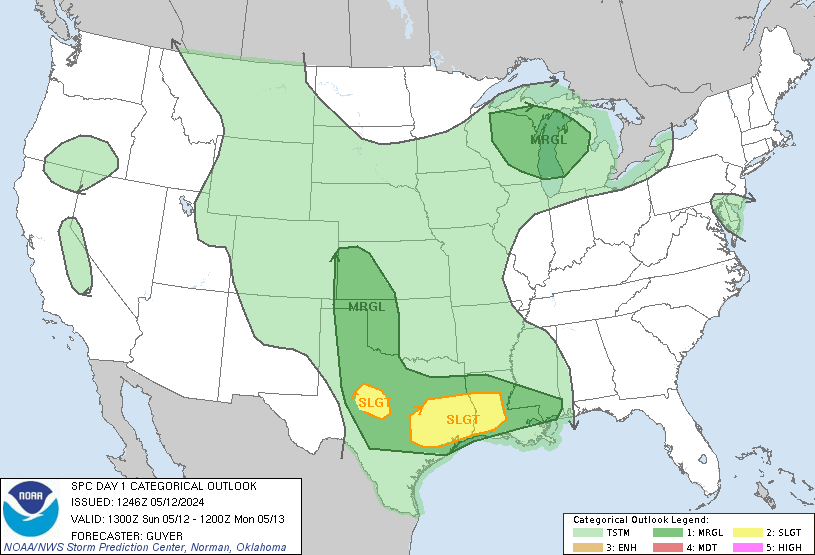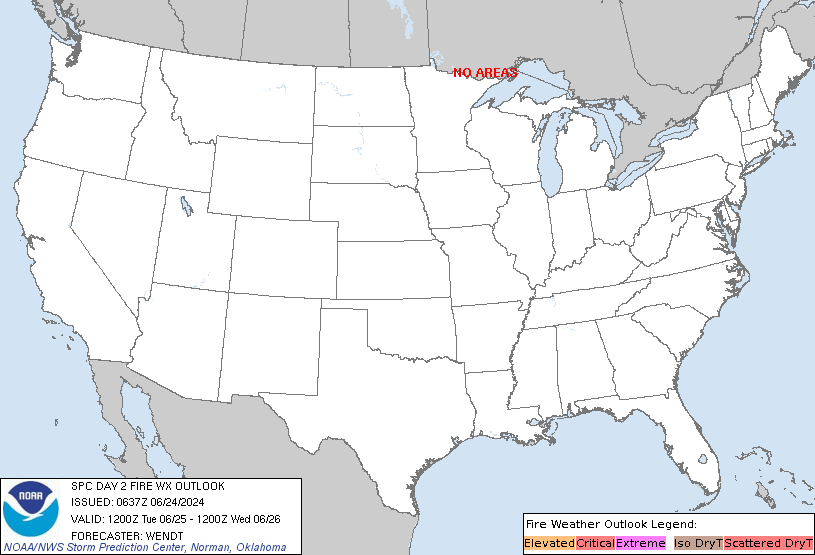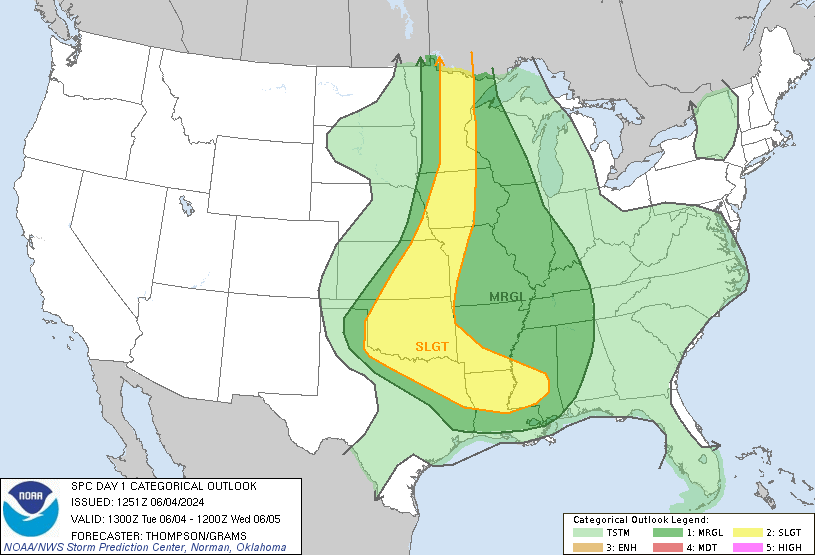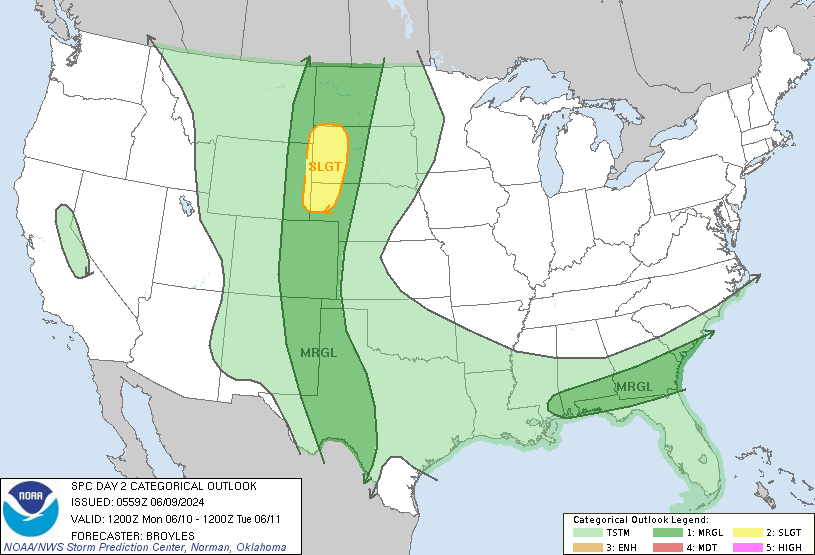SPC May 19, 2024 1300 UTC Day 1 Convective Outlook
SPC 1300Z Day 1 Outlook


Day 1 Convective Outlook NWS Storm Prediction Center Norman OK 0758 AM CDT Sun May 19 2024 Valid 191300Z - 201200Z ...THERE IS A MODERATE RISK OF SEVERE THUNDERSTORMS IN PORTIONS OF KANSAS... ...THERE IS A SLIGHT RISK OF SEVERE THUNDERSTORMS OVER PARTS OF EAST-CENTRAL/SOUTHEASTERN FLORIDA... ...SUMMARY... An organized swath of severe thunderstorm wind (potential derecho) is expected mainly across parts of Kansas this afternoon and evening, possibly extending into northern Oklahoma. Gusts of 75-100 mph are possible, along with large hail and a few tornadoes. ...Synopsis... A broad fetch of westerly to southwesterly flow will cover most of the central CONUS. This will persist downstream from a synoptic- scale trough over the Pacific Northwest that should amplify into the Great Basin region through the period. The downstream flow field contains several embedded shortwaves, including a convectively generated perturbation now over parts of KS/NE. This feature should eject northeastward over the upper Mississippi Valley this evening, and away from the main threat area. However, an upstream shortwave trough -- apparent in moisture-channel imagery over the Four Corners region -- will move east-northeastward and influence convective potential over the central Plains this afternoon and evening. Elsewhere aloft, a persistent trough was evident across portions of VA, the Carolinas, GA, and AL, with cyclonic flow downstream over the southern Atlantic Coast and as far south as most of the FL Peninsula. This trough should reach the NC/SC/GA coastlines and northwestern FL by 00Z, and south FL by 12Z tomorrow. The 11Z surface analysis showed a cold front from northeastern ON across Lower MI, western IL, west-central MO and east-central KS, where it is being overtaken by an outflow boundary arching southwestward across south-central KS to the OK Panhandle. The outflow boundary is expected to stall in the next few hours, then shift northward over southern and central KS through the day. A dryline extended from eastern CO across the western TX Panhandle to near LBB, MAF and northern Coahuila. The dryline should mix eastward slightly today, reaching near the KS/CO line and eastern TX Panhandle by mid/late afternoon. Elsewhere, a weak cold front was drawn from a low offshore from NC southwestward over northern FL, and should move slowly southward into central FL today. ...Central Plains... Thunderstorms are expected to develop during mid/late afternoon behind the dryline over the eastern Raton Mesa region, as well as along the dryline itself, and move east-northeastward to eastward into increasing moisture and instability. As they do, some of the activity should aggregate into clusters as smaller-scale outflows combine and enlarge. With supportive internal feedback of an organizing cold pool, associated forced ascent at the front and rear-inflow jet, and supportive midlevel winds for downward momentum transfer, as well as the residual and diurnally destabilized outflow boundary, the overall meso-alpha-scale pattern appears quite suitable for an organized, potentially significant-severe convective-wind swath to result. The most probable corridor for such growth still appears to be across KS in and near the "moderate risk" corridor, driven by wind probabilities. Initially separate dryline development over the northeastern TX Panhandle and northwestern OK may blend into (or even get undercut by outflow from) the broader event as well, after a few hours' discrete time to its south, with a threat of large hail, locally severe gusts and perhaps a tornado or two. Other afternoon development, along the dryline, in the mountains of northern CO and southeastern WY, and over the Black Hills, may move east- northeastward across a narrow moist sector and produce severe gusts and hail into parts of the adjoining High Plains of western NE and the Dakotas. Near and behind the KS-to-Panhandles dryline segment, the storm- initiation environment will be characterized by increasing large-scale ascent and upper divergence ahead of the ejecting Four Corners shortwave trough, as well as strong diurnal heating, mixing and deepening of the boundary layer. Superposition of these effects will lead to nearly 9 deg C/km lapse rates throughout the lower/ middle troposphere, supporting 2000-3000 J/kg MLCAPE just east of the dryline. A deep subcloud layer conducive to strong-severe downdrafts will be available to storms over western KS from the beginning, and should support growth/merger of resultant outflows before activity moves into greater moisture. Forced ascent of the moist boundary layer should help to sustain the forward-propagating complex into strengthening nocturnal MLCINH at least across eastern KS, and perhaps into parts of the lower Missouri Valley, before it weakens tonight. ...FL... Scattered thunderstorms should develop this afternoon near the I-95 corridor and roughly between MIA and the Space Coast, along and south of a weak cold front. Organized multicells and a few supercells are possible, offering large hail and damaging to locally severe gusts before they move offshore. An active Atlantic sea-breeze pattern will be augmented by mid/upper support preceding the trough aloft. Strong diurnal heating, a deep troposphere and rich low-level moisture (with dewpoints commonly in the 70s F and 16.5-18.5 g/kg mean mixing ratios) will support 2000-3000 J/kg peak MLCAPE. Though weak near-surface winds will limit hodograph size, 30-45 kt effective-shear magnitudes and potential boundary interactions will support storm organization, including supercell potential. ..Edwards/Goss.. 05/19/2024
Mostly Cloudy and 78 F at Fort Bragg / Simmons Army Airfield, NC
Fort Bragg aka Fort Liberty
Winds are Southwest at 11.5 MPH (10 KT). The pressure is 1008.9 mb and the humidity is 74%.
Last Updated on May 18 2024, 6:55 pm EDT.
Last Updated on May 18 2024, 6:55 pm EDT.
https://w1.weather.gov/data/obhistory/KFBG.html8:02 amMay 19, 2024
SPC Day 2 Fire Weather Outlook

SPC Day 2 Fire Weather Outlook
Day 2 Fire Weather Outlook NWS Storm Prediction Center Norman OK 0218 AM CDT Sun May 19 2024 Valid 201200Z - 211200Z ...CRITICAL FIRE WEATHER AREA FOR SOUTHERN NEW MEXICO... ...Synopsis... Mid-level flow will start to strengthen on Monday as a subtropical shortwave trough approaches the region. A very deeply mixed airmass (near 500mb) will be in place on Monday. Therefore, some of this stronger mid-level flow should transport to the surface relatively easily. A large portion of the Southwest and into the central Rockies will experience Critical meteorological conditions on Monday. The current Critical outline represents where the driest fuels are present. Some expansion of this Critical area may be needed if guidance comes in stronger with winds and/or if fuels dry significantly in the next 36 hours. Elsewhere, fire weather concerns remain low at this time due to moist fuels and high relative humidity. ..Bentley.. 05/19/2024 ...Please see www.spc.noaa.gov/fire for graphic product...
SPC May 19, 2024 0600 UTC Day 1 Convective Outlook
SPC 1200Z Day 1 Outlook


Day 1 Convective Outlook NWS Storm Prediction Center Norman OK 1256 AM CDT Sun May 19 2024 Valid 191200Z - 201200Z ...THERE IS A MODERATE RISK OF SEVERE THUNDERSTORMS IN SOUTHWEST TO CENTRAL KS... ...THERE IS A SLIGHT RISK OF SEVERE THUNDERSTORMS SEPARATELY IN EAST-CENTRAL TO SOUTHEAST FL... ...SUMMARY... Severe thunderstorms are expected across parts of Kansas into northwest Oklahoma from late afternoon into mid-evening, including the potential for a derecho. Destructive wind swaths of 80-100 mph may occur, with localized extreme gusts exceeding 100 mph possible. Very large hail and a few tornadoes are also anticipated. ...KS/OK vicinity... An active severe-weather day is expected during the late afternoon to mid-evening. Primary changes this outlook are to increase wind and hail probabilities with above-average guidance agreement regarding the likelihood of supercells evolving into multiple linear bows. Significant severe, from both hail and especially wind, appears likely. How far downstream higher-end intensity threats will persist towards the lower plains is more uncertain. General thunderstorm activity is expected to be ongoing within a low-level warm theta-e advection regime across parts of the central Great Plains. This will probably persist through much of the morning into the afternoon, becoming more centered on the Mid-MO Valley to Upper Midwest. Pronounced differential boundary-layer heating is expected between this early-day activity and full insolation that yields hot surface temperatures across the southern High Plains. With a plume of mid to upper 60s surface dew points overspreading much of western/central OK into central KS, beneath a plume of very steep mid-level lapse rates, a strongly unstable airmass will develop with MLCAPE of 2500-3500 J/kg becoming common. A strengthening upper-level jet across the Southwest, nosing over the southern Rockies, should aid in dryline sharpening by late afternoon. Initial very high-based thunderstorms should form off the Raton Mesa behind the dryline, while other storms form along the dryline near the TX Panhandle/western OK border, and in the north-central KS vicinity near the warm front. The far southern dryline storms in northwest OK and near the warm front in KS should remain semi-discrete longer, and will be most capable of producing very large hail and a couple tornadoes. Between these two corridors, CAM signals are fairly consistent that a mix of outflow-dominated clusters with embedded supercells will move east-northeast during the evening. This includes evolution into linear bowing segments with forecast soundings, indicating potential for intense rear-inflow jet development. Given the highly favorable thermodynamic environment, coupled with the impinging of a mid-level jetlet across the southern High Plains, this scenario appears probable. The southern to central Great Plains low-level jet will strengthen during the evening, which should result in a large MCS with embedded bowing structures persisting after dusk. CAM guidance is fairly quick to indicate diminishing intensity as MLCIN rapidly increases across much of OK into at least southeast KS. But given the potential for prolific, organized severe wind swaths upstream, have increased severe probabilities downstream from the Mid-MO Valley and deeper into OK. ...Western NE to western/central SD... Scattered thunderstorm development is expected along the northern portion of the dryline during the late afternoon to early evening as a narrow plume of mid to upper 50s surface dew points spreads north. With a more confined and more modestly buoyant warm-moist sector relative to KS southward, overall threat should consist of isolated to scattered large hail and severe wind. ...FL... Scattered afternoon thunderstorms appear likely to develop ahead of a slow-moving, positive-tilt shortwave trough over the Southeast. Best potential for a few supercells should be focused along the Atlantic Coast sea breeze across parts the central to south peninsula. Favorable deep-layer shear, in conjunction with large buoyancy, should foster a predominant threat of large hail, with isolated damaging winds possible as well. ..Grams/Bentley.. 05/19/2024
SPC May 19, 2024 0600 UTC Day 2 Convective Outlook
SPC 0600Z Day 2 Outlook


Day 2 Convective Outlook NWS Storm Prediction Center Norman OK 1251 AM CDT Sun May 19 2024 Valid 201200Z - 211200Z ...THERE IS A SLIGHT RISK OF SEVERE THUNDERSTORMS ACROSS CENTRAL/EASTERN NEBRASKA...NORTHERN KANSAS...SOUTHWEST IOWA AND NORTHWEST MISSOURI... ...SUMMARY... Severe thunderstorms are possible across parts of the central Plains Monday evening into the overnight hours. Additional more isolated strong to severe storms are possible from the Middle Mississippi Valley to Lower Michigan through Monday afternoon. ...Synopsis... A somewhat complex pattern is expected across the Plains to the upper Great Lakes on Monday. During the morning, an upper shortwave trough is forecast over the IA vicinity. Convection will likely be ongoing across parts of the upper MS Valley in association with this feature as it lifts northeast across WI. Further south, some guidance is hinting at a possible MCV or outflow over central MO related to the convective remnants of an intense MCS forecast in the Day 1/Sun period over KS. Across the central Plains, an area of broad, enhanced southwesterly mid/upper flow will persist over NE/KS, though large-scale ascent will remain weak through peak heating. Capping will likely suppress convection during the afternoon, and airmass recovery from convection in the Day 1 period will occur through the daytime hours. A potent lead upper shortwave trough, emanating from the larger-scale western U.S. upper trough, will eject into the central High Plains overnight. At the surface, a broad warm sector with dewpoints in the 60s to near 70 F will extend east/northeast from the central/southern Plains to the Mid/Upper MS Valley vicinity. A warm front will lift north through the day into northern WI/Lower MI. A dryline will extend south/southwest from northwest OK to southwest TX. Overnight, surface cyclogenesis will ensue across KS/NE as the upper shortwave trough approaches the region. A cold front will sharpen and begin to shift east across central NE/KS late in the period. ...Central Plains to Lower MO Valley... Severe potential will increase by early Monday evening as the upper shortwave trough moves into the central Rockies and large-scale ascent increases. Initial storm development over northeast CO into southwest NE/northwest KS will pose a risk for damaging gusts and hail. As a surface low develops east across KS/NE convection will increase in coverage, particularly over NE. Given timing of convection (mainly during the nighttime hours) and potential for linear development as a cold front sharpens and shifts east overnight, damaging gusts and hail will be the main hazards as storms approach the MO River by Tuesday morning. The southward extent of severe potential into KS is a bit uncertain. Strong capping will likely persist over the southern half of the state. ...Eastern IA into Lower MI... Convection will likely be ongoing Monday morning. Severe potential is uncertain during the morning, but any organized storms could pose a risk of marginally severe hail and locally strong gusts. Guidance suggests severe potential may increase with eastward extent, and into the afternoon, from northeast IL into Lower MI as stronger destabilization will occur ahead of morning activity. Effective shear magnitudes are forecast to be around 25-30 kt. Meanwhile, steepening low-level lapse rates, with a mixed boundary layer to near 850 mb is noted in forecast soundings. Marginal supercells capable of hail and strong gusts will be possible. If confidence increases, portions of this area may need higher probabilities in subsequent outlooks. ...Central MO vicinity... A somewhat conditional risk is possible across parts of the central MO vicinity. It is possible that an MCV migrating across the area or any remnant outflow related to Day 1/Mon activity could focus thunderstorm development during the late morning into afternoon. Large-scale ascent will be weak over the area, and deep-layer flow modest. However, thermodynamic profiles will support marginal hail and strong gusts if storms develop. ..Leitman.. 05/19/2024

